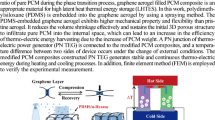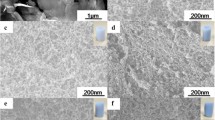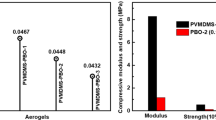Abstract
To develop graphene-based composite aerogels with improved compressive shape stability that suitable for high-temperature applications, poly (m-phenylene isophthalamide, PMIA) with excellent heat resistance and flame retardancy was used as the supporting material. The effects of PMIA content on aerogel morphology, structure, mechanical and thermal properties were discussed. Unlike other polymers, PMIA in the composite aerogels appeared as separate or stacked particles instead of interconnected framework or uniform coatings. Higher PMIA content tended to result in denser aerogels with smaller pores and thinner graphene sheet walls. The densified structure with plenty of PMIA particles incorporated was found to make the aerogel more rigid and less flexible. Their compressive strength therefore was greatly enhanced. Besides, it was also observed that the thermal conductivity of the prepared aerogels increased with the increase of PMIA content. Nevertheless, their thermal conductivity was still <0.045 W m−1 K−1, indicative of considerable thermal insulation ability. Given that, the prepared composite aerogels with enhanced compressive shape stability may have a broad application prospect in thermal insulation.

Highlights
-
PMIA-reinforced graphene aerogels (PGAs) are successfully prepared by a premixing method.
-
The resulted PGAs have smaller pores and thinner graphene walls with numerous PMIA particles incorporated.
-
PGAs can support >2000 times its own weight, indicative of enhanced compressive strength.
-
PGAs are good at thermal insulation with thermal conductivity values <0.045 W m−1 K−1.








Similar content being viewed by others
References
Le DK, Ng GN, Koh HW, Zhang X, Thai QB, Phan-Thien N, Duong HM (2020) Methyltrimethoxysilane-coated recycled polyethylene terephthalate aerogels for oil spill cleaning applications. Mater Chem Phys 239:122064. https://doi.org/10.1016/j.matchemphys.2019.122064
Kashyap S, Kabra S, Kandasubramanian B (2020) Graphene aerogel-based phase changing composites for thermal energy storage systems. J Mater Sci 55(10):4127–4156. https://doi.org/10.1007/s10853-019-04325-7
Wang J, Liu D, Li Q, Chen C, Chen Z, Song P, Hao J, Li Y, Fakhrhoseini S, Naebe M, Wang X, Lei W (2019) Lightweight, superelastic yet thermoconductive boron nitride nanocomposite aerogel for thermal energy regulation. ACS Nano 13(7):7860–7870. https://doi.org/10.1021/acsnano.9b02182
Maleki H, Hüsing N (2018) Current status, opportunities and challenges in catalytic and photocatalytic applications of aerogels: Environmental protection aspects. Appl Catal B Environ 221:530–555. https://doi.org/10.1016/j.apcatb.2017.08.012
Stergar J, Maver U (2016) Review of aerogel-based materials in biomedical applications. J Sol-Gel Sci Technol 77(3):738–752. https://doi.org/10.1007/s10971-016-3968-5
Hasan MA, Sangashetty R, Esther ACM, Patil SB, Sherikar BN, Dey A (2017) Prospect of thermal insulation by silica aerogel: a brief review. J I Eng Ser D 98(2):297–304. https://doi.org/10.1007/s40033-017-0136-1
Hu L, He R, Lei H, Fang D (2019) Carbon aerogel for insulation applications: a review. Int J Thermophys 40(4):39. https://doi.org/10.1007/s10765-019-2505-5
Benad A, Jürries F, Vetter B, Klemmed B, Hübner R, Leyens C, Eychmüller A (2018) Mechanical properties of metal oxide aerogels. Chem Mater 30(1):145–152. https://doi.org/10.1021/acs.chemmater.7b03911
Yang Z, Yu H, Li X, Ding H, Ji H (2019) Hyperelastic and hydrophobic silica aerogels with enhanced compressive strength by using VTES/MTMS as precursors. J Non-Cryst Solids 525:119677. https://doi.org/10.1016/j.jnoncrysol.2019.119677
Gorgolis G, Galiotis C (2017) Graphene aerogels: a review. 2D Mater 4(3):032001. https://doi.org/10.1088/2053-1583/aa7883
Lorenzetti A, Roso M, Bruschetta A, Boaretti C, Modesti M (2016) Polyurethane-graphene nanocomposite foams with enhanced thermal insulating properties. Polym Adv Technol 27(3):303–307. https://doi.org/10.1002/pat.3635
Korkmaz S, Kariper İA (2020) Graphene and graphene oxide based aerogels: synthesis, characteristics and supercapacitor applications. J Energy Storage 27:101038. https://doi.org/10.1016/j.est.2019.101038
Liao H, Chen W, Liu Y, Wang Q (2020) A phase change material encapsulated in a mechanically strong graphene aerogel with high thermal conductivity and excellent shape stability. Compos Sci Technol 189:108010. https://doi.org/10.1016/j.compscitech.2020.108010
Wu H, Wang Z-M, Kumagai A, Endo T (2019) Amphiphilic cellulose nanofiber-interwoven graphene aerogel monolith for dyes and silicon oil removal. Compos Sci Technol 171:190–198. https://doi.org/10.1016/j.compscitech.2018.12.017
Huang H, Chen P, Zhang X, Lu Y, Zhan W (2013) Edge-to-edge assembled graphene oxide aerogels with outstanding mechanical performance and superhigh chemical activity. Small 9(8):1397–1404. https://doi.org/10.1002/smll.201202965
Yue C, Feng J, Feng J, Jiang Y (2017) Ultralow-density and high-strength graphene aerogels composites for thermal insulation. Mater Lett 188:169–171. https://doi.org/10.1016/j.matlet.2016.11.028
Ha H, Shanmuganathan K, Ellison CJ (2015) Mechanically stable thermally crosslinked poly(acrylic acid)/reduced graphene oxide aerogels. ACS Appl Mater Interfaces 7(11):6220–6229. https://doi.org/10.1021/acsami.5b00407
Lu H, Li C, Zhang B, Qiao X, Liu C (2016) Toward highly compressible graphene aerogels of enhanced mechanical performance with polymer. RSC Adv 6(49):43007–43015. https://doi.org/10.1039/c6ra04995h
Qin Y, Peng Q, Ding Y, Lin Z, Wang C, Li Y, Xu F, Li J, Yuan Y, He X, Li Y (2015) Lightweight, superelastic, and mechanically flexible graphene/polyimide nanocomposite foam for strain sensor application. ACS Nano 9(9):8933–8941. https://doi.org/10.1021/acsnano.5b02781
Ren R, Wang Z, Ren J, Lv Y (2019) Highly compressible polyimide/graphene aerogel for efficient oil/water separation. J Mater Sci 54(7):5918–5926. https://doi.org/10.1007/s10853-018-03238-1
Ye S, Feng J (2014) Towards three-dimensional, multi-functional graphene-based nanocomposite aerogels by hydrophobicity-driven absorption. J Mater Chem A 2(27):10365–10369. https://doi.org/10.1039/c4ta01392a
Hu H, Zhao Z, Wan W, Gogotsi Y, Qiu J (2014) Polymer/graphene hybrid aerogel with high compressibility, conductivity, and “sticky” superhydrophobicity. ACS Appl Mater Interfaces 6(5):3242–3249. https://doi.org/10.1021/am4050647
García JM, García FC, Serna F, de la Peña JL (2010) High-performance aromatic polyamides. Prog Polym Sci 35(5):623–686. https://doi.org/10.1016/j.progpolymsci.2009.09.002
Chen W, Weng W (2016) Ultrafine lauric-myristic acid eutectic/poly (meta-phenylene isophthalamide) form-stable phase change fibers for thermal energy storage by electrospinning. Appl Energy 173:168–176. https://doi.org/10.1016/j.apenergy.2016.04.061
Zhang Q, Xu X, Lin D, Chen W, Xiong G, Yu Y, Fisher TS, Li H (2016) Hyperbolically patterned 3D graphene metamaterial with negative poisson’s ratio and superelasticity. Adv Mater 28(11):2229–2237. https://doi.org/10.1002/adma.201505409
Qiu L, Liu JZ, Chang SLY, Wu Y, Li D (2012) Biomimetic superelastic graphene-based cellular monoliths. Nat Commun 3(1):1241. https://doi.org/10.1038/ncomms2251
Adhikari B, Biswas A, Banerjee A (2012) Graphene oxide-based hydrogels to make metal nanoparticle-containing reduced graphene oxide-based functional hybrid hydrogels. ACS Appl Mater Interfaces 4(10):5472–5482. https://doi.org/10.1021/am301373n
Wang J, Ellsworth M (2009) Graphene aerogels. ECS Trans 19(5):241–247. https://doi.org/10.1149/1.3119548
Yao L, Lee C, Kim J (2010) Fabrication of electrospun meta-aramid nanofibers in different solvent systems. Fibers Polym 11(7):1032–1040. https://doi.org/10.1007/s12221-010-1032-6
Maleki H, Durães L, Portugal A (2014) An overview on silica aerogels synthesis and different mechanical reinforcing strategies. J Non-Cryst Solids 385:55–74. https://doi.org/10.1016/j.jnoncrysol.2013.10.017
Yue C, Feng J, Feng J, Jiang Y (2016) Low-thermal-conductivity nitrogen-doped graphene aerogels for thermal insulation. RSC Adv 6(12):9396–9401. https://doi.org/10.1039/c5ra23236h
Lu Y, Zhang F, Zhang T, Leng K, Zhang L, Yang X, Ma Y, Huang Y, Zhang M, Chen Y (2013) Synthesis and supercapacitor performance studies of N-doped graphene materials using o-phenylenediamine as the double-N precursor. Carbon 63:508–516. https://doi.org/10.1016/j.carbon.2013.07.026
Wang T, He X, Li Y, Li J (2018) Novel poly(piperazine-amide) (PA) nanofiltration membrane based poly(m -phenylene isophthalamide) (PMIA) hollow fiber substrate for treatment of dye solutions. Chem Eng J 351. https://doi.org/10.1016/j.cej.2018.06.165
Pramila J, Melbiah JSB, Rana D, Gandhi NN, Nagendran A, Mohan D (2018) Permeation characteristics of tailored poly (m-phenylene isophthalamide) ultrafiltration membranes and probing its efficacy on bovine serum albumin separation. Polym Test 67:218–227. https://doi.org/10.1016/j.polymertesting.2018.03.006
Lee JW, Han SS, Zo SM, Choi SM (2018) Cellulose/poly-(m-phenylene isophthalamide) porous film as a tissue-engineered skin bioconstruct. Results Phys 9:113–120. https://doi.org/10.1016/j.rinp.2018.02.003
Zhang Q, Hao M, Xu X, Xiong G, Li H, Fisher TS (2017) Flyweight 3D graphene scaffolds with microinterface barrier-derived tunable thermal insulation and flame retardancy. ACS Appl Mater Interfaces 9(16):14232–14241. https://doi.org/10.1021/acsami.7b01697
Cheng Y, Zhou S, Hu P, Zhao G, Li Y, Zhang X, Han W (2017) Enhanced mechanical, thermal, and electric properties of graphene aerogels via supercritical ethanol drying and high-temperature thermal reduction. Sci Rep. 7(1):1439. https://doi.org/10.1038/s41598-017-01601-x
Kim WS, Moon SY, Koyanagi J, Ogasawara T (2016) Three-dimensional porous graphene-based ultra-lightweight aerofoam exhibiting good thermal insulation. Adv Compos Mater 25(sup1):105–113. https://doi.org/10.1080/09243046.2016.1193939
Villar-Rodil S, Martı́nez-Alonso A, Tascón JMD (2001) Studies on pyrolysis of Nomex polyaramid fibers. J Anal Appl Pyrol 58-59:105–115. https://doi.org/10.1016/S0165-2370(00)00124-8
Villar-Rodil S, Paredes JI, Martínez-Alonso A, Tascón JMD (2001) Atomic force microscopy and infrared spectroscopy studies of the thermal degradation of nomex aramid fibers. Chem Mater 13(11):4297–4304. https://doi.org/10.1021/cm001219f
Deoghare RR, Sirsat PM, Tamboli RA (2014) Design and analysis of pressure disc type filter for beverages making equipment manufacturer. Int J Eng Sci Res Technol 3(4):2014–2017. http://www.ijesrt.com/issues%20pdf%20file/Archives-2014/April-2014/38.pdf
Zhu C, Han TY-J, Duoss EB, Golobic AM, Kuntz JD, Spadaccini CM, Worsley MA (2015) Highly compressible 3D periodic graphene aerogel microlattices. Nat Commun 6(1):6962. https://doi.org/10.1038/ncomms7962
Zhang X, Sui Z, Xu B, Yue S, Luo Y, Zhan W, Liu B (2011) Mechanically strong and highly conductive graphene aerogel and its use as electrodes for electrochemical power sources. J Mater Chem 21(18):6494–6497. https://doi.org/10.1039/C1JM10239G
Guo K, Hu Z, Song H, Du X, Zhong L, Chen X (2015) Low-density graphene/carbon composite aerogels prepared at ambient pressure with high mechanical strength and low thermal conductivity. RSC Adv 5(7):5197–5204. https://doi.org/10.1039/C4RA08800J
Acknowledgements
This work was supported by National Natural Science Foundation of China (Grant No. 51904312), Shandong “Taishan Youth Scholar Program” and Scientific Research Foundation of Civil Aviation University of China (2020KYQD115). The authors are deeply grateful to these supports.
Author information
Authors and Affiliations
Corresponding author
Ethics declarations
Conflict of interest
The authors declare that they have no conflict of interest.
Additional information
Publisher’s note Springer Nature remains neutral with regard to jurisdictional claims in published maps and institutional affiliations.
Supplementary information
Rights and permissions
About this article
Cite this article
Chen, W., Liu, S., Dong, Y. et al. Poly (m-phenylene isophthalamide)/graphene composite aerogels with enhanced compressive shape stability for thermal insulation. J Sol-Gel Sci Technol 96, 370–381 (2020). https://doi.org/10.1007/s10971-020-05396-8
Received:
Accepted:
Published:
Issue Date:
DOI: https://doi.org/10.1007/s10971-020-05396-8




